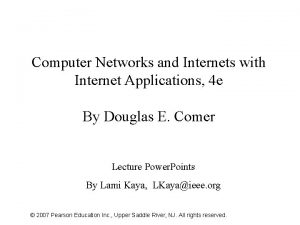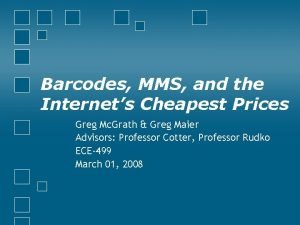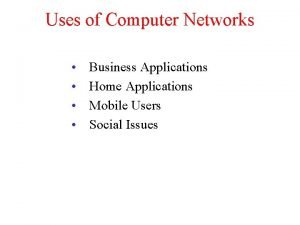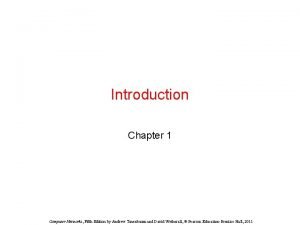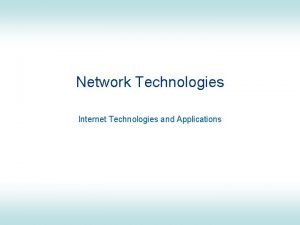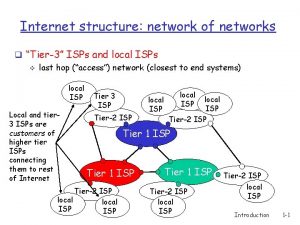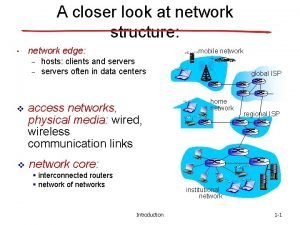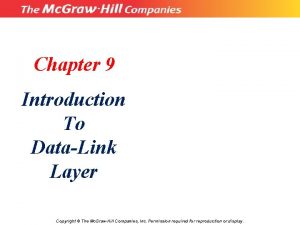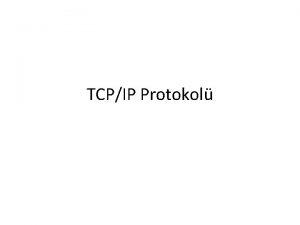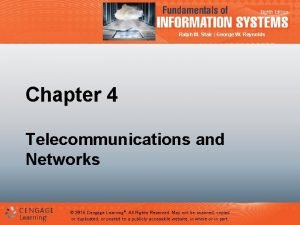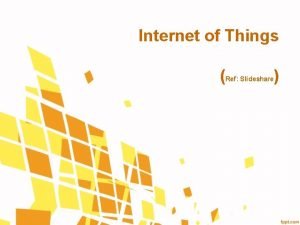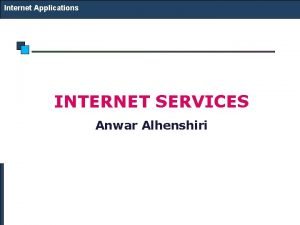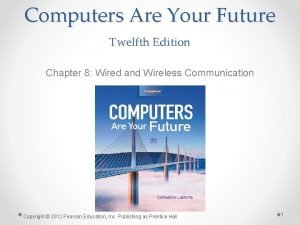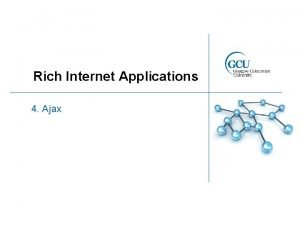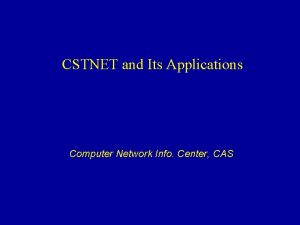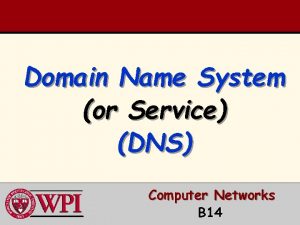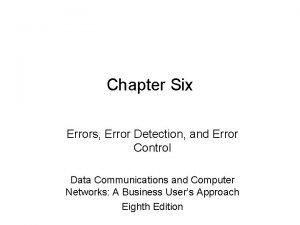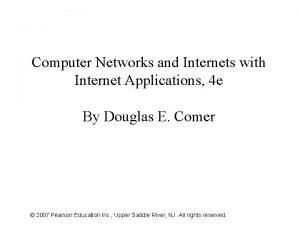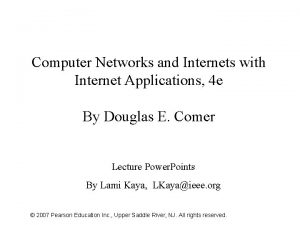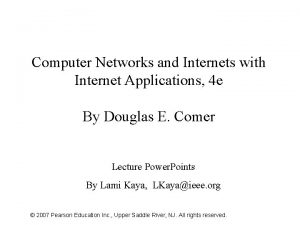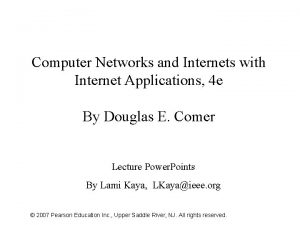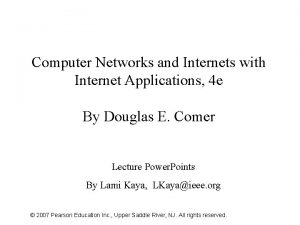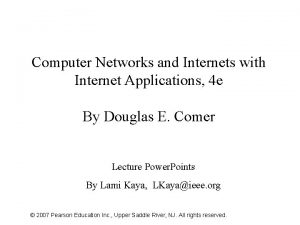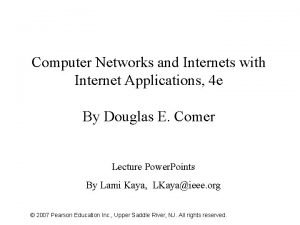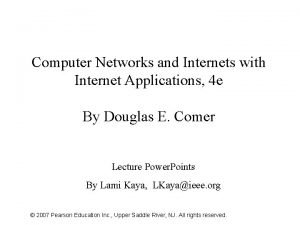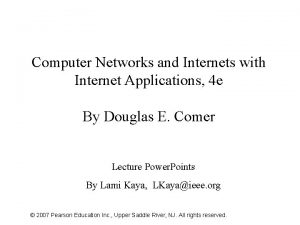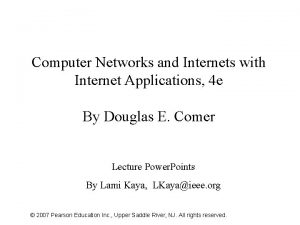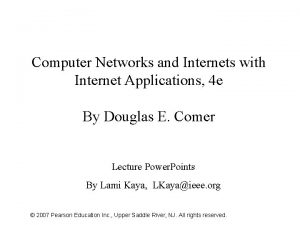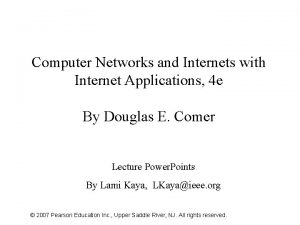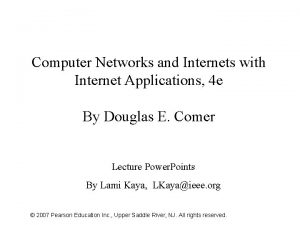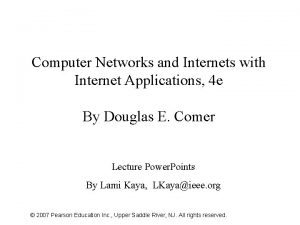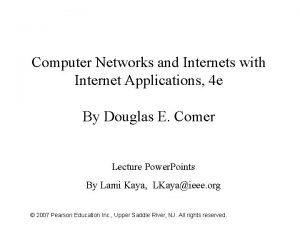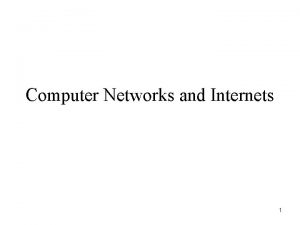Computer Networks and Internets with Internet Applications 4


















































- Slides: 50

Computer Networks and Internets with Internet Applications, 4 e By Douglas E. Comer Lecture Power. Points By Lami Kaya, LKaya@ieee. org © 2007 Pearson Education Inc. , Upper Saddle River, NJ. All rights reserved.

Chapter 12 Long-Distance And Local Loop Digital Technologies © 2007 Pearson Education Inc. , Upper Saddle River, NJ. All rights reserved.

Topics Covered • • • 12. 1 Introduction 12. 2 Digital Telephony 12. 3 Synchronous Communication 12. 4 Digital Circuits, NIUs, And DSU/CSUs 12. 5 Telephone Standards 12. 6 DS Terminology And Data Rates 12. 7 Lower Capacity Circuits 12. 8 Intermediate Capacity Digital Circuits 12. 9 Highest Capacity Circuits 12. 10 Optical Carrier Standards 12. 11 The C Suffix 12. 12 Synchronous Optical NETwork (SONET) © 2007 Pearson Education Inc. , Upper Saddle River, NJ. All rights reserved.

Topics Covered (cont) • • • 12. 13 The Local Subscriber Loop 12. 14 ISDN 12. 15 Asymmetric Digital Subscriber Line Technology 12. 16 Other DSL Technologies 12. 17 Cable Modem Technology 12. 18 Upstream Communication 12. 19 Hybrid Fiber Coax 12. 20 Fiber To The Curb 12. 21 Head-End And Tail-End Modems 12. 22 Wireless Alternatives For Special Cases 12. 23 Broadcast Satellite Systems © 2007 Pearson Education Inc. , Upper Saddle River, NJ. All rights reserved.

12. 1 Introduction This chapter • Discuss how to overcome the size and distance limitations of LANs • Focuses on two fundamental building blocks – point-to-point digital communication – high-speed digital access to individual homes and businesses • Shows how these building blocks can be used to form a large packet-switching NW system Digital Telephony © 2007 Pearson Education Inc. , Upper Saddle River, NJ. All rights reserved.

12. 2 Digital Telephony (1) • Analog signals has problems in a long-distance environment – Because electrical signals degrade as they pass over copper wires • amplifiers are required to boost the signal – Each amplifier distorts the signal slightly and introduces noise • Digital communication avoids the problem of noise by – encoding the original audio signal into digital form, • Signals formats can be converted – analog-to-digital (A-to-D) converter “digitization” – digital-to-analog (D-to-A) converter © 2007 Pearson Education Inc. , Upper Saddle River, NJ. All rights reserved.

12. 2 Digital Telephony (2) • An A-to-D converter – takes an analog signal as input, – samples the signal regularly, – and computes a number that gives the current level of the signal at the time of the sample • Digitization converts an analog signal into a continuous stream of numbers • Figure 12 1 illustrates the concept • Nyquist's sampling theorem states that – if a continuous signal is sampled at a rate greater than twice the highest significant frequency, • the original signal can be reconstructed from the samples © 2007 Pearson Education Inc. , Upper Saddle River, NJ. All rights reserved.

© 2007 Pearson Education Inc. , Upper Saddle River, NJ. All rights reserved. 8

12. 2 Digital Telephony (3) • In addition to choosing a sampling rate, we must choose a range of integer values to be used – The tradeoff is between accuracy and data size: – a large range of values allows the signal to be reproduced more accurately, but requires the transmission of more bits – Researchers selected the range 0 to 255 for voice • The sampling scheme is known as – Pulse Code Modulation (PCM) • A variant known as – Adaptive Pulse Code Modulation (APCM) • achieves a more dynamic range by sending a sequence of differences rather than absolute values © 2007 Pearson Education Inc. , Upper Saddle River, NJ. All rights reserved.

12. 3 Synchronous Communication (1) • The facilities used for digitized voice differ from the systems used for data – because voice systems use synchronous or clocked technology, – while most data NWs use asynchronous technology • A synchronous NW consists of a system designed to move data at a precise rate – In particular, the NW does not slow down as the traffic increases – and data emerges from the NW at exactly the same rate it enters • What might happen to a digitized voice signal when it is transferred across an unsynchronized NW? – As more traffic enters such a NW, the transmission of a given signal can experience increased delay – Thus, a stream of data moving across the NW might slow down temporarily when other traffic enters the NW, – and then speed up again when the traffic subsides © 2007 Pearson Education Inc. , Upper Saddle River, NJ. All rights reserved.

12. 3 Synchronous Communication (2) • If audio from a digitized phone call is delayed – the human listening to the call will hear the delay as annoying interference or noise • So, to avoid such problems – the telephone system is carefully designed to transmit additional information along with the digitized data and to ensure continuous transmission • Receiving equipment uses the additional information to synchronize its clock – and ensure that data leaves the NW at exactly the same rate as it entered © 2007 Pearson Education Inc. , Upper Saddle River, NJ. All rights reserved.

12. 4 Digital Circuits, NIUs, And DSU/CSUs (1) • Digital telephone facilities have formed the basic longdistance connections in large computer NWs – it is possible to lease a point-to-point digital circuit – telephone companies lease the circuits for a monthly fee; • fee depends on the capacity as well as the distance spanned • To use a leased digital circuit – one must agree to follow the rules of the telephone system – including adhering to the standards that were designed for transmitting • Because the computer industry and the telephone industry developed independently – the standards for telephone system digital circuits differ from those used in the computer industry © 2007 Pearson Education Inc. , Upper Saddle River, NJ. All rights reserved.

12. 4 Digital Circuits, NIUs, And DSU/CSUs (2) • A special piece of HW is needed to interface a computer to a digital circuit provided by a telephone company – Known as a Data Service Unit / Channel Service Unit (DSU/ CSU) • Figure 12 2 illustrates connection • The NW Interface Unit (NIU) is the last piece of equipment owned by the telephone company, – and marks the boundary between facilities provided by the phone company and those provided by the subscriber – The telephone company refers to the boundary as the (demark) • The CSU handles line termination and diagnostics – it can test whether the line has been disconnected • The CSU also contains a “loopback” test facility – allows the CSU to transmit a copy of all data that arrives across the circuit back to the sender without further processing • A CSU also prohibits excessive consecutive 1 bits – by using either use bit stuffing or use a balanced encoding scheme © 2007 Pearson Education Inc. , Upper Saddle River, NJ. All rights reserved.

© 2007 Pearson Education Inc. , Upper Saddle River, NJ. All rights reserved. 14

12. 5 Telephone Standards • A DSU must accommodate the digital transmission standards used by the phone company – In the U S , standards for digital telephone circuits were given names that consist of the letter T followed by a number • One of the most popular is known as T 1; • many companies use a T 1 circuit for data • T-standards are not universal – Japan adopted a modified version of the T-series standards – And Europe chose a slightly different scheme (letter E ) • Figure 12 3 lists the data rates of several digital circuit © 2007 Pearson Education Inc. , Upper Saddle River, NJ. All rights reserved.

© 2007 Pearson Education Inc. , Upper Saddle River, NJ. All rights reserved. 16

12. 6 DS Terminology And Data Rates • A single voice channel requires 64 Kbps (8000 8 -bit samples per second) • The data rate of the T 1 standard was chosen to allow the circuit to carry 24 independent voice calls (plus a small amount of overhead) • A device is used to “multiplex the calls at one end of a T 1 circuit, – and another device is used to demultiplex calls at the other end • The standards that specify how to multiplex multiple phone calls onto a single connection – Are known as Digital Signal Level standards – The names are written as the letters DS followed by a number • Ex: DS 1 denotes a service that can multiplex 24 phone calls onto a single circuit • Despite the minor technical distinctions – the terms T 1 and DS 1 are often interchanged © 2007 Pearson Education Inc. , Upper Saddle River, NJ. All rights reserved.

12. 7 Lower Capacity Circuits • Currently, T 1 circuits are among the most popular – A T 1 circuit can be too expensive for home or small businesses – Furthermore, many companies do not need the capacity of a T 1 circuit • In such cases, it is possible to lease a lower-capacity circuit, – which is known as “fractional” • Fractional T 1 circuits are available with capacity much less than 1. 544 Mbps • One of the most popular fractional T 1 rates consists of a circuit that operates at the DS 0 rate • Phone companies use the term Time Division Multiplexing (TDM) – multiplexing digital voice calls onto a high capacity circuit – or subdividing a T 1 circuit into lower capacity circuits © 2007 Pearson Education Inc. , Upper Saddle River, NJ. All rights reserved.

12. 8 Intermediate Capacity Digital Circuits • What if a company needs a circuit with slightly more than T 1 capacity, – but only T 3 circuits are available? • Because a T 3 circuit has 28 times the capacity of a T 1 circuit, – T 3 costs substantially more than T 1 – Thus, it does not make sense to lease a T 3 circuit and only use a small fraction of the capacity • Technology called inverse multiplexing has been developed to handle intermediate capacity circuits • The technology allows one to lease multiple T 1 circuits between two points, and use them like a single higher-capacity circuit – The inverse mux accepts a stream of data from the computer, and sends part of the data over each of the digital circuits • Figure 12 4 illustrates the concept © 2007 Pearson Education Inc. , Upper Saddle River, NJ. All rights reserved.

© 2007 Pearson Education Inc. , Upper Saddle River, NJ. All rights reserved. 20

12. 9 Highest Capacity Circuits • Telephone companies use the term “trunk” – to denote a high-capacity circuit • Major trunk connections are used across the country or between countries • A series of standards was defined for high-capacity digital circuits – Known as the Synchronous Transport Signal (STS) standards • Figure 12 5 summarizes various STS standards – All data rates in the table are given in Mbps © 2007 Pearson Education Inc. , Upper Saddle River, NJ. All rights reserved.

© 2007 Pearson Education Inc. , Upper Saddle River, NJ. All rights reserved. 22

12. 10 Optical Carrier Standards Optical Carrier (OC) • The terminology arises because higher data rates associated with the STS standards require optical fiber • To be precise, one should observe a distinction between the STS and OC terminology – the STS standards refer to the electrical signals used in the digital circuit interface (i e , over copper), – while the OC standards refer to the optical signals that propagate across the fiber © 2007 Pearson Education Inc. , Upper Saddle River, NJ. All rights reserved.

12. 11 The C Suffix • The STS and OC terminology described above has one additional feature not shown in Figure 12 5: – an optional suffix of the letter C , which stands for concatenated • The presence of the suffix denotes a circuit with no inverse multiplexing – That is, an OC-3 circuit • consists of three OC-1 circuits operating at 51. 840 Mbps each, • and is intended to be used as three circuits – An OC-3 C (STS-3 C) circuit, however, • is a single circuit operating at 155. 520 Mbps • Is a single circuit operating at full speed better than multiple circuits operating at lower rates? – The answer depends on how the circuit is being used • In general, having a single circuit operating at full capacity provides more flexibility and eliminates the need for inverse multiplexing © 2007 Pearson Education Inc. , Upper Saddle River, NJ. All rights reserved.

12. 12 Synchronous Optical NETwork (SONET) • In North America, the standards use the term • Synchronous Optical (SONET) • In Europe they are known as the – Synchronous Digital Hierarchy (SDH) • SONET specifies details such as – how data is framed – how lower-capacity circuits are multiplexed into a high-capacity circuit – and how synchronous clock information is sent along with data • Although most data NWs use SONET as an encoding scheme on a single point-to-point circuit, the standard provides more possibilities – In particular, it is possible to build a high-capacity counter rotating ring NW using SONET technology that handles single-point failures © 2007 Pearson Education Inc. , Upper Saddle River, NJ. All rights reserved.

© 2007 Pearson Education Inc. , Upper Saddle River, NJ. All rights reserved. 26

12. 13 The Local Subscriber Loop • Although leased data circuits provide the ability to send data across long distances, – higher-speed connections are needed that extend to individual residences and businesses • Connection between the phone company Central Office (CO) and an individual subscriber's residence or place of business is called – “local loop” or “local subscriber line” • Currently, most local loops use analog signals – because they were designed for conventional analog telephone service • Analog phone service is often referred to as POTS – which stands for Plain Old Telephone Service • Indeed, most subscribers currently obtain access to NWs by using a telephone to dial a local service provider • Although dialup modems have improved over the years – the voice BW and S/N of telephone lines limit the rate © 2007 Pearson Education Inc. , Upper Saddle River, NJ. All rights reserved.

12. 14 Integrated Services Digital Network (ISDN) (1) • ISDN provides digitized voice and data to subscribers over conventional local loop wiring • That is, ISDN uses the same type of twisted pair copper wiring as the analog telephone system • From a subscriber's point of view, ISDN offers three separate digital channels, designated – B , and D (usually written 2 B + D ) channel – B channels, which each operate at a speed of 64 Kbps, • are intended to carry digitized voice, data, or compressed video; – D channel, which operates at 16 Kbps • is intended as a control channel – User has a total of 144 Kbps available • the underlying system operates at 160 Kbps • so the remaining 16 Kbps are consumed by synchronization and framing – In general, a subscriber uses the D channel to request services which are then supplied over the B channels © 2007 Pearson Education Inc. , Upper Saddle River, NJ. All rights reserved.

12. 14 Integrated Services Digital Network (ISDN) (2) • In fact, ISDN uses a form of time division multiplexing – To provide the illusion of multiple channels of data traveling over a single pair of wires • When the phone companies first defined ISDN many years ago, – 64 Kbps seemed fast compared to dialup modems • which were operated at less than 10 Kbps • Phone companies hoped that customers would use ISDN for both local and long distance digital communication analogous to the way they use the voice telephone system • As the years passed, however, – dialup modems improved, – and alternative technologies were invented that provided high data rates across the local loop at lower cost • Consequently, ISDN now is an expensive alternative that offers little throughput – Therefore, it’s not commonly used, expect in cases of making use of existing infrastructure © 2007 Pearson Education Inc. , Upper Saddle River, NJ. All rights reserved.

12. 15 Asymmetric Digital Subscriber Line (ADSL) Technology (1) • One of of technology for providing digital services across the local loop – Digital Subscriber Line (DSL) • There are several variants – Because the names differ by the first word, the set is collectively referred – x. DSL • Perhaps the most interesting x. DSL technology is known as – Asymmetric Digital Subscriber Line (ADSL) • From a subscriber's point of view, ADSL provides the ability to send and receive digital information at high speed • As the name implies, however, the service is asymmetric – the asymmetry arises from the bit rate – the available BW is divided to make the bit rate in one direction much higher © 2007 Pearson Education Inc. , Upper Saddle River, NJ. All rights reserved.

12. 15 Asymmetric Digital Subscriber Line (ADSL) Technology (2) • ADSL is optimized for typical – users who receive much more information than they send – ADSL provides a higher bit rate “downstream” (to the subscriber) • than “upstream” (from the subscriber to the provider) – the asymmetry makes ADSL inappropriate for connections that send more data than they receive • A business that has an online catalog available to customers – would not benefit from ADSL because the business would tend to send more data than it receives • • How fast can ADSL operate? The maximum downstream rate is an astounding 6. 144 Mbps The maximum upstream rate is 640 Kbps Because there is a mandatory NW control channel that requires 64 Kbps, the effective upstream rate for user data is 576 Kbps © 2007 Pearson Education Inc. , Upper Saddle River, NJ. All rights reserved.

12. 15 Asymmetric Digital Subscriber Line (ADSL) Technology (3) • ADSL is optimized for typical – users who receive much more information than they send – ADSL provides a higher bit rate “downstream” (to the subscriber) • than “upstream” (from the subscriber to the provider) – the asymmetry makes ADSL inappropriate for connections that send more data than they receive • A business that has an online catalog available to customers – would not benefit from ADSL because the business would tend to send more data than it receives • • How fast can ADSL operate? The maximum downstream rate is an astounding 6. 144 Mbps The maximum upstream rate is 640 Kbps Because there is a mandatory NW control channel that requires 64 Kbps, the effective upstream rate for user data is 576 Kbps © 2007 Pearson Education Inc. , Upper Saddle River, NJ. All rights reserved.

12. 15 Asymmetric Digital Subscriber Line (ADSL) Technology (4) • ADSL does not require any changes in local loop wiring – because it is designed to run over the same twisted pair • Furthermore, ADSL does not preempt the local loop – it can run simultaneously over the same wires as the phone service • Figure 12. 7 illustrates how ADSL modems connected • How does ADSL achieve high data rates over twisted pair? – many local loops accommodate signals at frequencies higher than those used by the telephone system – the ability to carry signals depends on the distance, gauge of wiring used, and level of electrical interference • To accommodate differences in local loop characteristics, ADSL is adaptive – That is, when ADSL modems are powered on, they probe the line between them to find its characteristics • and then agree to communicate using techniques that are optimal © 2007 Pearson Education Inc. , Upper Saddle River, NJ. All rights reserved.

12. 15 Asymmetric Digital Subscriber Line (ADSL) Technology (5) • ADSL uses a scheme known as – Discrete Multi Tone modulation (DMT) • which combines FDM and inverse multiplexing • The FDM in DMT is implemented by dividing the bandwidth into 286 separate frequencies or sub-channels – with 255 frequencies used for downstream data transmission – and 31 used for upstream data transmission, – with 2 taken for control information • Conceptually, there is a separate ``modem'' running on each subchannel, which has its own modulated carrier • Two ends of ADSL assess the signal quality at each frequency, and use the quality to select a modulation scheme – If a particular frequency has a high signal-to-noise ratio • ADSL selects a modulation scheme that encodes many bits per baud; – if the quality on a given frequency is low, • ADSL selects a modulation scheme that encodes fewer bits per baud © 2007 Pearson Education Inc. , Upper Saddle River, NJ. All rights reserved.

© 2007 Pearson Education Inc. , Upper Saddle River, NJ. All rights reserved. 35

12. 16 Other DSL Technologies • In addition to ADSL, other DSL technologies have been developed – Each uses the BW to achieve a slightly different goal – each has advantages for some applications • Symmetric Digital Subscriber Line (SDSL) – provides symmetric bit rates in both directions • High-Rate Digital Subscriber Line (HDSL) – HDSL provides a DS 1 bit rate (i e , 1. 544 Mbps) in two directions – One of the disadvantages of HDSL is a short distance limitation – To overcome the wiring disadvantage, a variant known as HDSL 2 has been proposed that runs over two wires – An advantage of HDSL arises from its ability to tolerate failure gracefully • if one of the two twisted pairs fails, the modems do not fail completely, but instead continue to operate at one half the maximum bit rate • Very-high bit rate Digital Subscriber Line (VDSL) © 2007 Pearson Education Inc. , Upper Saddle River, NJ. All rights reserved.

12. 17 Cable Modem Technology (1) • Telephone twisted-pair local loop inherent some limitations – Such as electrical characteristics – the wiring places an upper bound on how fast data can be transferred • the lack of shielding makes the wiring susceptible to interference, which can substantially degrade performance for some subscribers • Community Antenna Tele. Vision (CATV) has the following features – offers higher speed than telephone wiring – less susceptible to electromagnetic interference – and does not require completely new infrastructure: cable television • In some countries residential areas already have cable TV wiring – The media consists of coaxial cable – the cable system HW uses broadband signaling (FDM) © 2007 Pearson Education Inc. , Upper Saddle River, NJ. All rights reserved.

12. 17 Cable Modem Technology (2) • Data passed to the modem at the CATV center is encoded on the carrier, – which is then broadcast across the cable to all subscribers • A matching modem at the subscriber's location picks out the carrier signal, – extracts the encoded digital information, and passes the resulting stream to the subscriber's computer © 2007 Pearson Education Inc. , Upper Saddle River, NJ. All rights reserved.

12. 17 Cable Modem Technology (3) • In a large metropolitan area, a single cable supplier can have millions of subscribers – impossible to allocate a separate carrier frequency to each • as a result, the FDM scheme does not scale • Instead of assigning a unique frequency to each subscriber • the cable company uses one frequency for a set of subscribers • From a subscriber's point of view, – sharing the BW with other subscribers can be a disadvantage • Although cable modems can deliver up to 36 Mbps – effective rate available to each individual station varies over time • If N subscribers share a single frequency, the amount of capacity available to an individual subscriber can be as little as 1/N © 2007 Pearson Education Inc. , Upper Saddle River, NJ. All rights reserved.

12. 18 Upstream Communication (1) • Another CATV serious disadvantage as a local loop technology – optimized to carry signals in the downstream direction only – no provision in a conventional cable system for upstream • original system could not be used to provide two-way communication • How can a cable system be modified to provide upstream comm. ? – instead of sending all data over the cable infrastructure • the cable system handles only downstream traffic • while upstream traffic travels across a dialup telephone connection – the chief advantage of a dual-path scheme lies in its low cost – the existing cable system does not need to change – the chief disadvantage lies in the clumsy interface © 2007 Pearson Education Inc. , Upper Saddle River, NJ. All rights reserved.

12. 18 Upstream Communication (2) • More recent technology has focused on – modifications to the basic infrastructure that permit two-way communication across the cable • Addition of an upstream data path requires significant changes to the cable system – which will incur substantial cost • To help justify costs – cable companies are investigating uses for an upstream path beyond computer NW connections • For example, an upstream path can also be used – to provideo demand or interactive TV © 2007 Pearson Education Inc. , Upper Saddle River, NJ. All rights reserved.

12. 19 Hybrid Fiber Coax (1) • One of the most promising technologies that provide twoway communication across a cable system is – Hybrid Fiber Coax (HFC) • The system uses – a combination of optical fibers and coaxial cables, – with fiber used for the central facilities (trunk) and coax used for the connections to individual subscribers (feeder circuit) • HFC is hierarchical • It uses fiber optics for the portion of the NW that requires the highest BW – and uses coax for parts that can tolerate lower capacities © 2007 Pearson Education Inc. , Upper Saddle River, NJ. All rights reserved.

12. 19 Hybrid Fiber Coax (2) • HFC uses a combination of FDM and TDM – BW between 50 and 450 MHz is used for analog TV • (with 6 MHz devoted to each TV channel), – BW from 450 MHz to 750 MHz is used for downstream – BW from 5 through 50 MHz is used for upstream • TDM operates within a group of one or more subscribers that are assigned to share the BW – Usually, a group is chosen on the basis of geographic proximity (e g , in a neighborhood) – The group shares one carrier frequency, • with only one subscriber in the group able to receive a packet at any time • The higher BW of fiber makes it possible – to multiplex several independent groups across the trunk lines © 2007 Pearson Education Inc. , Upper Saddle River, NJ. All rights reserved.

12. 20 Fiber To The Curb Fiber The Curb (FTTC) • FTTC is similar to HFC because it uses optical fiber for high capacity trunks • The idea is to run optical fiber close to the end subscriber, and then use copper for the feeder circuits • FTTC differs from HFC – because it uses two media in each feeder circuit to allow the cable system to provide an additional service • company must run an additional wire to each house to use HFC – First circuit uses coaxial cable to deliver interactive video – Second circuit uses twisted pair, which is used to carry voice © 2007 Pearson Education Inc. , Upper Saddle River, NJ. All rights reserved.

12. 21 Head-End And Tail-End Modems • “head-end” modem refers to the modem – used at the central office, • “tail-end” modem refers to the modem – used at the subscriber's location • The head-end modems used to deliver data over cable follow the – Cable Modem Termination System (CMTS) standard • Cable providers may allow subscribers to interactively configure their NW access or order special services (pay-per-view movie) – Many cable systems implement the Data Over Cable System Interface Standard (DOCSIS) – DOCSIS does not specify what can be ordered or how to manage accounting and billing • it only specifies how a subscriber sends in requests and receives replies © 2007 Pearson Education Inc. , Upper Saddle River, NJ. All rights reserved.

12. 22 Wireless Alternatives For Special Cases • To handle special cases, a variety of alternative local loop technologies have been explored – use wireless NWs • The IEEE has developed a new higher-speed wireless technology that can provide high throughput – Wi. MAX developed by a consortium of vendors – Wi. MAX is classified as a Metropolitan Area NW (MAN) • because it spans larger distance than a LAN, but less than a WAN – Wi. MAX can be used as a local loop replacement – WIMAX provide higher-speed access between a neighborhood and a central office © 2007 Pearson Education Inc. , Upper Saddle River, NJ. All rights reserved.

12. 23 Broadcast Satellite Systems (1) • Another alternative uses digital communication satellites – Initially satellites were used by telecommunication companies • primarily as an alternative to terrestrial lines • in situations where terrestrial lines were either expensive or infeasible such as across oceans or in mountainous areas – Early satellites provided point-to-point communication • Commercial companies – could build, deploy, and operate communication satellites • Can satellites be used as a local loop technology? • If so, are they only appropriate for special cases? • or can they provide a general-purpose infrastructure? © 2007 Pearson Education Inc. , Upper Saddle River, NJ. All rights reserved.

12. 23 Broadcast Satellite Systems (2) • Satellites offer advantages – has more BW than a dialup connection – can reach an arbitrary geographic location • Soma disadvantages of satellites – High orbit of a geosynchronous satellite means long delays – The ground station equipment required to transmit a signal to a satellite (known as an uplink) is both expensive and large • making it inappropriate for individuals or small businesses • only large corporations can afford such facilities • To devise a low-cost local loop system that uses satellites, two innovations were needed: – Instead of treating satellites as point-to-point, a broadcast mechanism – Instead of a large, expensive ground station, an alternative uplink transmission path was used © 2007 Pearson Education Inc. , Upper Saddle River, NJ. All rights reserved.

12. 23 Broadcast Satellite Systems (3) • The satellite broadcast mechanism uses the same principle described in Chapter 9 – a satellite broadcasts each packet, – and all stations tuned to the satellite's transmission receive a copy • To ensure that packets only arrive at their intended destination, each station is assigned a unique address – Stations filter incoming packets in the same way a LAN NIC • although the satellite channel is shared, • a given station only accepts packets sent to the station's address; • other packets are discarded • A satellite can contain multiple transmitters – Each operating on a separate channel (i e , frequency) • a broadcast satellite can use FDM to achieve higher BW, – and then use TDM to allow multiple receivers to share the BW © 2007 Pearson Education Inc. , Upper Saddle River, NJ. All rights reserved.

12. 23 Broadcast Satellite Systems (4) • Broadcast satellite technology extends the notion of asymmetric delivery to use following – A broadcast satellite is used for downstream traffic; – Upstream traffic travels over a lower-capacity NW such as a conventional dialup telephone connection • Each subscriber must have a telephone connection as well as an antenna (i e a receiving ``dish'') • To make the entire system work – routing is arranged carefully to ensure that traffic sent to any of the satellite subscribers is forwarded to the satellite vendor • which then transmits the packet over the satellite © 2007 Pearson Education Inc. , Upper Saddle River, NJ. All rights reserved.
 Computer networks and internets with internet applications
Computer networks and internets with internet applications Computer networks and internets
Computer networks and internets Differences between virtual circuits and datagram networks
Differences between virtual circuits and datagram networks Compare internets
Compare internets Backbone networks in computer networks
Backbone networks in computer networks Uses of computer in business
Uses of computer in business Principles of network applications in computer networks
Principles of network applications in computer networks Business application in computer network
Business application in computer network Business application in computer network
Business application in computer network Internet transport protocol in computer networks
Internet transport protocol in computer networks Aim lans
Aim lans Internet structure network of networks
Internet structure network of networks Internet structure network of networks
Internet structure network of networks The internet is a combination of networks glued together by
The internet is a combination of networks glued together by Osi vs tcp/ip
Osi vs tcp/ip Intserv vs diffserv
Intserv vs diffserv Error detection in computer networks
Error detection in computer networks Byte stuffing and bit stuffing
Byte stuffing and bit stuffing Flag byte with byte stuffing framing method
Flag byte with byte stuffing framing method Rarp cisco
Rarp cisco Analogue and digital transmission in computer networks
Analogue and digital transmission in computer networks Web and http in computer networks
Web and http in computer networks Hamming distance in computer network
Hamming distance in computer network Protocols and standards in computer networks
Protocols and standards in computer networks Error detection computer networks
Error detection computer networks Applications of internet
Applications of internet Internet of things slideshare
Internet of things slideshare Applications of internet
Applications of internet Applications of internet
Applications of internet Rich internet applications with ajax
Rich internet applications with ajax Cstnet
Cstnet Internet or internet
Internet or internet Crc in computer networks
Crc in computer networks Crc in computer networks
Crc in computer networks Traffic management in computer networks
Traffic management in computer networks Tpdu in computer networks
Tpdu in computer networks What is optimality principle in computer networks
What is optimality principle in computer networks Snmp model in computer networks
Snmp model in computer networks What is optimality principle in computer networks
What is optimality principle in computer networks Definition of computer
Definition of computer Intro dns
Intro dns Icmp in computer networks
Icmp in computer networks Framing in computer network
Framing in computer network Dns in computer networks
Dns in computer networks Computer networks assignment
Computer networks assignment Difference between computer network and distributed system
Difference between computer network and distributed system Routing algorithms in computer networks
Routing algorithms in computer networks Error control in computer networks
Error control in computer networks What is optimality principle in computer networks
What is optimality principle in computer networks Switching in data link layer
Switching in data link layer Layered tasks in computer networks
Layered tasks in computer networks

